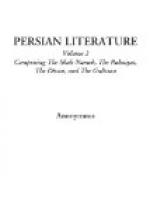THE GULISTAN
BY
SA’DI
[Translation by James Ross]
INTRODUCTION
The Persian poet Sa’di, generally known in literary history as Muslih-al-Din, belongs to the great group of writers known as the Shirazis, or singers of Shiraz. His “Gulistan,” or “Rose Garden,” is the mature work of his life-time, and he lived to the age of one hundred and eight. The Rose Garden was an actual thing, and was part of the little hermitage, to which he retired, after the vicissitudes and travels of his earlier life, to spend his days in religious contemplation, and the embodiment of his experience in reminiscences, which took the form of anecdotes, sage and pious reflections, bon-mots, and exquisite lyrics. When a friend visited him in his cell and had filled a basket with nosegays from the garden of the poet with roses, hyacinths, spikenards, and sweet-basils, Sa’di told him of the book he was writing, and added:—“What can a nosegay of flowers avail thee? Pluck but one leaf from my Rose Garden; the rose from yonder bush lasts but a few days, but this Rose must bloom to all eternity.”
Sa’di has been proved quite correct in this estimate of his own work. The book is indeed a sweet garden of unfading freshness. If we compare Sa’di with Hafiz, we find that both of them based their theory of life upon the same Sufic pantheism. Both of them were profoundly religious men. Like the strong and life-giving soil out of whose bosom sprang the rose-tree, wherein the nightingales sang, was the fixed religious confidence, which formed the support of each poet’s mind, amid all the vagaries of fancy, and the luxuriant growth of fruit and flower which their genius gave to the world. Hafiz is the Persian Anacreon. As he raises his voice of thrilling and unvarying sweetness, his steps reel, he waves the thyrsus, and his flushed cheek shows the inspiration of the vine. To him the Supreme Being has much in common with the Indian or Thracian Dionysus, the god of perennial youth, joyous revel, and exhilaration. Hafiz can never be the guide, though he may be the cheerer of mortals, adding more to the gayety than to the wisdom of life. But both in the western and in the eastern world Sa’di must always be looked upon as the guide and enlightener of those who taste life, and love poetry. It has been said by a wise man that poetry is the great instructor of mature minds. Many a man turning away in weariness from the controversies, the insincerities, and the pretentiousness of the intellectualists around him, has exclaimed, “Give me my Horace.” But Horace with all his bonhommie, his common sense, and his acuteness, is but the representative of a narrow Roman coterie of the Augustan age. How thin, flimsy, and unspiritual does he appear in comparison with the marvellous depth, the spiritual insight, the tenderness and power of expression which characterized Sa’di.




